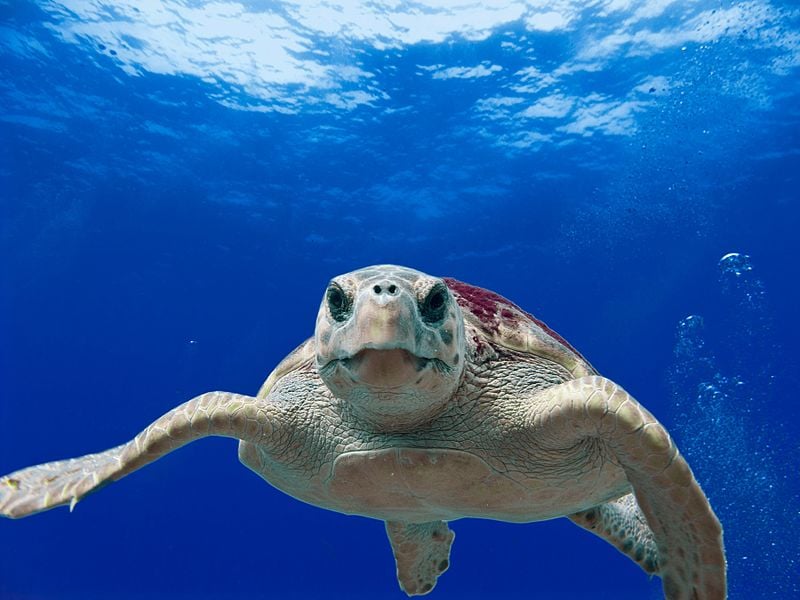A FEMALE loggerhead turtle has laid 72 eggs on the Los Boliches beach in Fuengirola.
The nesting took place on the night of August 3-4 on the urban beach, where the turtle built a nest and then laid over 70 eggs.

Turtle nesting on a beach bordering the Alboran Sea has never before been documented.
READ MORE:
WATCH: Police release sea turtle caught in fishing net off Spain’s Costa Blanca
The event has put Los Boliches beach in the spotlight for marine researchers who are now studying the causes of this unprecedented nesting behaviour.
This species, the loggerhead turtle (Caretta caretta), is the most abundant in the Mediterranean and the Atlantic Ocean, having stable breeding areas in the Mediterranean on beaches in Greece, Cyprus, Turkey or Libya, and sporadically in coastal areas of Tunisia, Italy, France, Spain or Algeria, where a clutch was recorded last year.

The first recording of a sea turtle nesting in Almeria—the closest area in Spain to this recent nesting in Malaga—was in July 2001.
In subsequent years, new nests have been extended along the Spanish Mediterranean coast, with documented nests in different locations along the coast between Barcelona and Almeria as well as in the Balearic Islands.
Experts are now investigating the possible cause of this recent nesting.
Sea turtles are animals that have a high tendency to return to the beaches where they were born to reproduce and nest.
Considering the loggerhead reaches sexual maturity within 17–33 years, and records of reproductive activity on these beaches only go back 30 years, this Fuengirola egg-laying rarity has raised a series of questions, yet to be answered.
Additionally, although this nesting took place within the time parameters in which the turtles of this species come to Mediterranean beaches to make their nests, the usual time-frame is between May and August.
The progressive warming of the Mediterranean and most of its beaches due to climate change could be one cause of this nesting which favours the reproductive needs of the species.
The turtle’s arrival in Fuengirola could mean an extension of its known nesting area to the Malaga coasts, signifying that other turtles could have laid their eggs on other beaches along the Costa del Sol.
In the case of the nesting on the Los Boliches beach, the 72 eggs found have been transferred to another site, a decision taken by experts in the area with the approval of the Junta.

The original nest was found very close to the shore; usually the clutches are made further from the water’s edge.
It is believed the mother turtle was probably unable to find a better site due to the presence of people on the beach and nearby lights on the promenade and in nearby buildings.
The survival of the eggs deposited in a too wet environment could, according to experts, drastically reduce the chances of the eggs hatching.
In view of all these circumstances and due to the very important significance of this nesting, the 72 eggs found were collected and transferred to try and help most reach full term.
Most of the eggs have been transferred to a quiter beach in Marbella, near Cabopino where there is no artificial lighting.
In addition, seven eggs have been transferred to Bioparc Fuengirola where, in an incubator and attended to by experts in reptile reproduction, their development and hatching are monitored.
The hatching is expected to take place between 80 and 90 days.
The loggerhead sea turtle facts:
- The largest of all hard-shelled turtles, loggerheads are named for their massive heads and strong jaws.
- Their reddish-brown shell, or carapace, is heart-shaped. Extremities form spade-shaped fins.
- The loggerhead is considered a ‘keystone species,’ meaning that other animals in its ecosystem depend on it for survival.
- Type: Reptiles
- Diet: Carnivore (fish, molluscs, tunicates, jellyfish and sponges).
- Group Name: Flotilla
- Average life span in the wild: 50 or more years
- Maximum size of adults in the Mediterranean: 77 cm curved carapace length and about 100 cm in total.
- Weight: Adults males generally weigh about 113 kg, loggerheads of more than 454 kg have been found.
- Age of sexual maturity between 21 and 34 years. The average clutch size in the Mediterranean is 110 eggs.
- Populations in the Mediterranean, Atlantic, Pacific and Indian Oceans
- International protection: Vulnerable or endangered status according to the red book of the International Union for Conservation of Nature (IUCN)
Click here to read more Spain News from The Olive Press.



